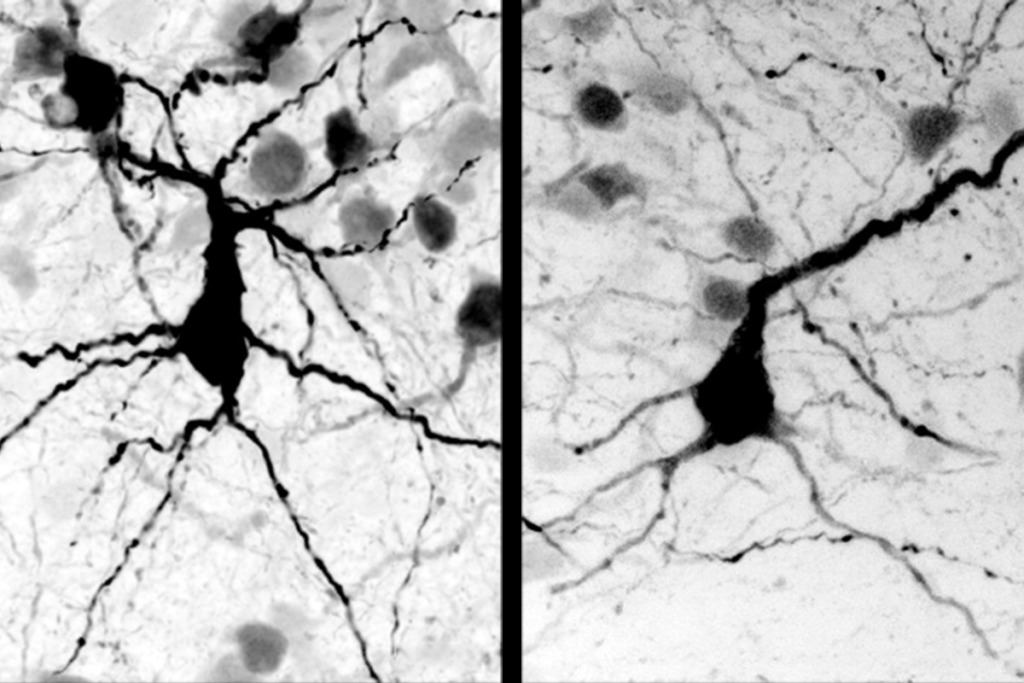Newly discovered aspects of fragile X spur next wave of drugs
Many drugs for fragile X syndrome have failed in large clinical trials, but candidates that target new aspects of the condition may fare better.

Many drugs for fragile X syndrome have been tested in large clinical trials, but none have proven effective. But candidates that target newly uncovered aspects of the condition are showing promise.
Fragile X syndrome typically results from mutations in the gene FMR1. It is characterized by intellectual disability, hyperactivity, seizures and — in one in three cases — autism. The mutations lead to a loss of FMRP, the protein FMR1 encodes.
According to the leading theory about fragile X, FMRP represses protein production at synapses, the junctions between neurons. And so loss of the protein leads to a buildup of proteins at synapses, causing them to malfunction.
A receptor called mGluR5, which sits on the surface of neurons, controls much of this protein production. The receptor’s location makes it an easy target for drugs that turn it off and restore protein levels to near normal.
In a flurry of promising tests in mice, drugs that block mGluR5 appeared to reverse features of fragile X. However, none of these drugs seemed to work in clinical trials of people with the condition, perhaps because the trials did not use the best markers to measure outcome.
The high-profile failures led to soul-searching in the field. Researchers began looking at other proteins and pathways that may offer targets to treat fragile X — including those that control the birth of neurons and fine-tune the strength of synapses.
“It’s important to have an open mind and look for other pathophysiology associated with fragile X,” says Lu Chen, professor of neurosurgery, psychiatry and behavioral sciences at Stanford University in California. “Hyperactive mGluR signaling is one of the many physiological deficits in fragile X, but not the only one.”
Looking inward:
One new approach focuses on proteins inside the cells rather than on the surface.
“All the focus was on the membrane and the receptor because those are druggable targets, but it’s actually not the mGluR5 receptor that’s the bad part” in fragile X, says Gary Bassell, professor and chair of cell biology at Emory University in Atlanta, Georgia. “It’s the molecules that are tethered to the receptor, and operating downstream of the receptor, that are altered.”
Bassell is investigating one such tethered molecule: an enzyme called phosphoinositide 3-kinase, or PI3K. One form of PI3K is hyperactive in mice missing FMR1 — and in blood cells from people with fragile X syndrome. PI3K activates a pathway called mTOR, which spurs cells to produce proteins, so hyperactivity of PI3K contributes to excess protein production at synapses1.
In collaboration with the drug company GlaxoSmithKline, Bassell and his colleagues are testing an experimental drug called GSK6A, which stymies the hyperactive PI3K. In mice missing FMR1, the drug normalizes protein synthesis and reverses problems with learning, decision-making and social interactions, the researchers reported in July2.
A version of the drug is in clinical trials as a cancer treatment; Bassell says the drug is likely to be well tolerated, because it suppresses only one form of PI3K and leaves others functional.
The drug may also work in other forms of autism, because researchers have found excessive signaling through PI3K in such cases. “Research on fragile X, in particular on PI3K, will have broader implications,” Bassell says.
Zooming out:
Other teams are taking a broad view of fragile X syndrome by looking at how neurons form in the first place.
Continual production of neurons in the hippocampus, a brain region important for learning and memory, is critical for processing information.
Stem cells in the hippocampus that give rise to neurons divide excessively in mice lacking FMR1, according to a 2016 study3. And the stem cells do not mature into neurons, leading to learning problems in the mice.
Hyperactivation of an enzyme called MDM2, which tags proteins for destruction, drives the excess cell division. Injecting the mice with an experimental drug that blocks MDM2’s ability to tag a protein called p53 normalizes the cell division; it also alleviates the learning problems.
Even though the mice in the study are young adults, “we can still rescue and treat the learning and memory deficit,” says lead investigator Xinyu Zhao, professor of neuroscience at the University of Wisconsin-Madison.
As the mutant mice age, their brains lose neural stem cells in the hippocampus, and their cognitive abilities decline. In these aging mutants, an enzyme called EP300, which tags proteins with acetyl groups, is hyperactivated. Blocking EP300 prevents neural stem cell loss and eases the cognitive problems, Zhao’s team reported earlier this year4.
“I’m not saying that treating the stem cells [or] targeting neurogenesis is better” than targeting mGluR5, Zhao says. “I’m just saying that we should give everything some consideration since we don’t have a way to treat it yet.”
Promising pathway:
Another line of research reframes FMR1’s role in protein synthesis. For instance, an analysis last year found that not all of the proteins overproduced in fragile X mice are harmful5.
“Some of the proteins that are increased might be beneficial adaptations that we should potentiate rather than inhibit,” says lead investigator Emily Osterweil, assistant professor at the Centre for Discovery Brain Sciences at the University of Edinburgh in Scotland.
A study published in May also suggests that excessive protein production is not the main culprit in fragile X. In that study, researchers looked at neurons made from skin cells of people with the syndrome and found that many of them show typical rates of protein production.
These and other results have spurred researchers to look at how FMR1 affects other pathways altered in fragile X.
For instance, an August study showed that loss of FMRP impairs neurons’ ability to fine-tune the strength of their connections, a process critical to learning6.
“We discovered a totally different set of signaling molecules whose function is altered in fragile X,” says Chen, the study’s lead investigator. “That gives us more opportunity to treat.”
Chen’s team treated neurons derived from people with fragile X with chemicals that silence synapses. Ordinarily, this would trigger a process called homeostatic plasticity, which involves compensatory changes in the strength of synapses. But this compensation is absent in the fragile X neurons, the researchers reported.
Chen’s team used a gene-editing tool to repair the FMR1 mutation in the neurons. The repair restores the compensation. Chen says the cells could be used to screen for compounds that rescue plasticity.
Restoring normalcy in mice, or even in cells, is a long way from establishing effectiveness in people, as the mGluR5 saga illustrates. But researchers say they are most likely to find a treatment that works if they use multiple strategies. In the meantime, much of the research on fragile X syndrome is focused on mGluR5, and on finding the best markers to measure a drug’s outcome.
References:
- Gross C. et al. J. Neurosci. 30, 10624-10638 (2010) PubMed
- Gross C. et al. Neuropsychopharmacology Epub ahead of print (2018) PubMed
- Li Y. et al. Sci. Transl. Med. 8, 336ra61 (2016) PubMed
- Li Y. et al. Nat. Commun. 9, 2494 (2018) PubMed
- Thomson S.R. et al. Neuron 95, 550-563 (2017) PubMed
- Zhang Z. et al. Sci. Transl. Med. 10, eaar4338 (2018) PubMed
Recommended reading

New organoid atlas unveils four neurodevelopmental signatures
Explore more from The Transmitter

The Transmitter’s most-read neuroscience book excerpts of 2025

Neuroscience’s leaders, legacies and rising stars of 2025


